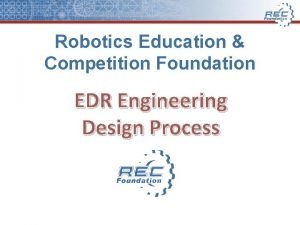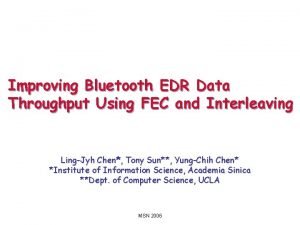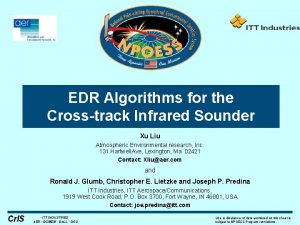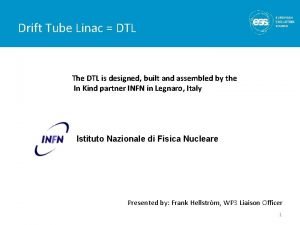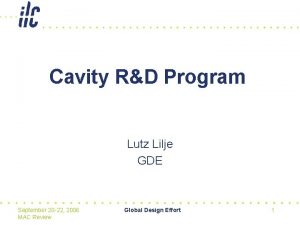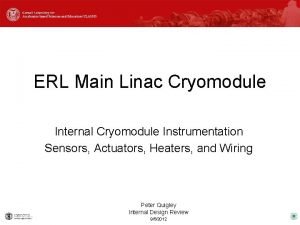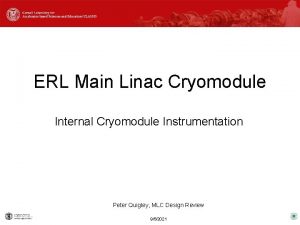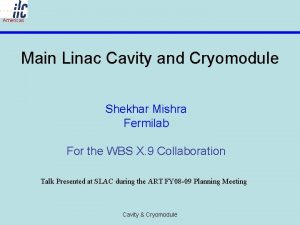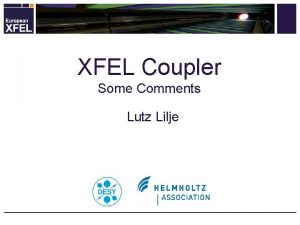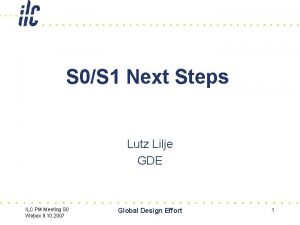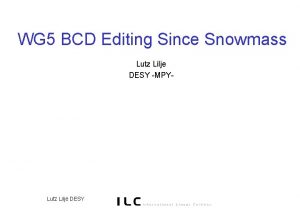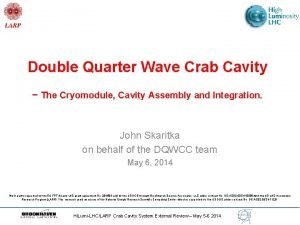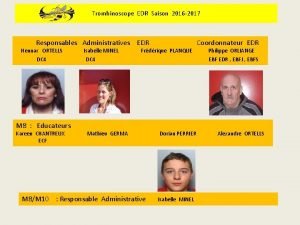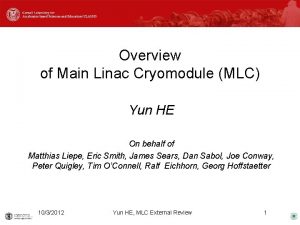Main Linac EDR Cavity Cryomodule Discussion Lutz Lilje











- Slides: 11

Main Linac EDR: Cavity & Cryomodule Discussion Lutz Lilje DESY 5. 2. 2007 Beijing ILC Workshop Global Design Effort 1

ILC EDR: Just a few Questions: • Engineering view – What detail is required? – What part of the system do we need freeze at which time? – Where can I insert changes (to be cheaper, better. . . ) without affecting other components? – If there is a influence to some system, what is the impact? – Whom do I have to talk to anyway? !? • Topic view: – What are the test needed to put forward a change request? – What is the mechanism to make the proposal a baseline (or part of the EDR)? 5. 2. 2007 Beijing ILC Workshop Global Design Effort 2

ILC EDR: Just a few more Questions: • Project view: – Is there a benefit to the project from this change? – What level of detail is required for the EDR? – What is the timeline? – Have we developed models for this EDR process e. g. for the industrialization or organizing the whole endeavour? – Is there a way of re-prioritizing efforts? • These are only a very few of those being raised. . 5. 2. 2007 Beijing ILC Workshop Global Design Effort 3

Basic Approach • Work forward. . . – What are tests needed to prove my design change? • E. g. Cavity shape change necessitates a beam test – See TTF experience. • Life-time testing – E. g. large-grain cavities in pulsed operation • Integrated systems test – E. g. vibration measurement on the center quadrupole and detailed comparison with the recent measurements of the TTF III modules and supports • When can we expect the results? • Working backward – What is latest date for choosing gradient? • E. g. site layout – When is the freeze of the module design? • Can one define the maximum space for a component and still proceed with the design? – Mechanical part of the tuner system • Are there things still changeable after that without major impact? – E. g. shield tubing sizes 5. 2. 2007 Beijing ILC Workshop Global Design Effort 4

Request for Information • Too complex to rely on individual’s knowledge of the project – Therefore formalization required – Facilitate input in projct tools e. g. RDB database • Request to Technical Groups – Provide information on topic under (re-)design • • Description Justification Estimated impact on – other components/systems – Classification: Severe, significant, minor, none – Time needed to re-design Estimated deadline Estimated effort e. g. – manpower and investment – Test needed » to prove validity e. g. feasibility, lifetime, beam tests, integrated systems test » Test deferrable to the period after project approval Provide deadlines for severe (significant, . . . ) changes required by other systems components – in second iteration as a crosscheck Request to CF&S – Provide some major deadlines • • When do we have to specify the linac length? Request to project management – Advise on developing industrialization models 5. 2. 2007 Beijing ILC Workshop Global Design Effort 5

Simple example: Cryo pipe sizes • Description – Cryo tubing inside the module • Justification – Optimise design • Impact – Other components in module – minor – 3 month (? ) • Deadline – possibly even after EDR • Effort – thorough crosscheck with 3 D design model – Helium flow simulations – Test needed • Confirm flow simulations in any module test stand 5. 2. 2007 Beijing ILC Workshop Global Design Effort 6

Simple examples: Large-grain niobium material • Description – Use large crystal material for cavities • Justification – Lower cost • Impact on other systems: – none – influence on preparation is external to the project (done by companies) • Deadline: – Before cavity order • Effort – reasonable number of cavities (10 -30) – Test needed: • Performance, Feasibility of tank welding (should be a no-brainer) • Module test: can be done after EDR 5. 2. 2007 Beijing ILC Workshop Global Design Effort 7

Simple Example: Linac Gradient • Impact on other systems: – CF&S – severe – ~1 year re-design for everybody. . . • Deadline: – End of 2008 (year before EDR) • Effort: – Significant number of cavities – Next-generation cavity preparation infrastructure – Tests • Execute S 0/S 1 plan, • Remark: Estimation by EC – which made life somewhat simpler. . . 5. 2. 2007 Beijing ILC Workshop Global Design Effort 8

Complex example: Cavity shape • Impact on other systems – depends on strategy: Increase linac gradient or increase cavity yield • Estimated deadline: – ? ? ? • Effort – several cavities – Tests needed: • Feasibility: Multi-cell performance • Beam test: HOM damping • Systems test if full package including coupler and tuner is used 5. 2. 2007 Beijing ILC Workshop Global Design Effort 9

Input for Project Tools • The information should guide the development of an overall ILC planning – need pre-defined categories – process of getting the data should provide crosscheck via affected systems/components 5. 2. 2007 Beijing ILC Workshop Global Design Effort 10

Summary • • Interesting and positive discussion Need to channel the inputs Request for input from technical systems A process used for approaching the complexity of this topic has been proposed • Prepare for use of project tools 5. 2. 2007 Beijing ILC Workshop Global Design Effort 11

